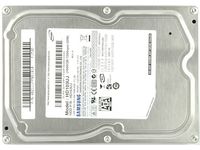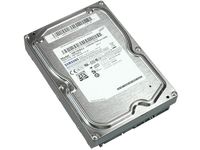Tom’s Winter 2008 Hard Drive Guide
Samsung: Spinpoint F
Samsung currently offers three hard drive series. You will find a comprehensive overview on these drives in the article Mainstream, Business or Eco? Samsung Terabyte Drives Compared. All Spinpoint drives mentioned on this page are 3.5” desktop hard drives with SATA/300 interfaces and 32 MB of cache memory.
Spinpoint F for the Masses (HD103UJ)
The Spinpoint F has been Samsung’s terabyte mainstream hard drive for roughly a year now. When it was introduced in 2007, it was the first terabyte hard drive that stored its entire capacity on only three platters. Today, all four 3.5” drive makers are at comparable density levels, but not all of them managed to beat Samsung’s excellent throughput. As you will see in the benchmark section, the Spinpoint F at 1 TB is still one of the best performers when it comes to sequential data transfer rates. Only Seagate’s new Barracuda 7200.11 at 1.5 TB and Samsung’s RAID edition drive provide higher throughput.
As always, it is hard to release a perfect product. While the Spinpoint F is a winner when it comes to sequential throughput, its power consumption is not top of the class anymore, which results in average performance per watt results. It is also not the quickest drive for data access and I/O performance, but it still reaches good results in the PCMark05 application benchmark. We found it impressive to see that the Spinpoint F still does well as a mainstream drive, despite its age of almost one year. If you get a good deal for this drive, there is not much to speak against it.
Spinpoint RAID Edition for Enthusiasts (HE103UJ)
The better choice for enthusiasts is the RAID edition Spinpoint by Samsung, as it offers improved performance and is validated for 24/7 operation. While the regular Spinpoint F reached up to 118 MB/s throughput, the RAID edition delivered almost 120 MB/s sequential read throughput. More importantly, access time and I/O performance improved as well, most likely as a result of modified access patterns, as the RAID edition makes noticeably more noise. Fortunately, we still cannot call it “noisy,” and we liked that it even required a bit less power than the regular Spinpoint F.
The improvements in performance and power consumption are reflected nicely when we look at performance per watt. The Spinpoint F RAID edition reached good results in the streaming read test, but only average standing in the workstation I/O test. WD’s Caviar Black or the Hitachi Deskstar 7K1000.B provide better performance per watt. If you want your system to run 24/7, to be available for downloads or other services, then you should make sure that your hard drive was designed to support continuous operation. That’s definitely the case for the Samsung (and other) RAID edition drives.
Get Tom's Hardware's best news and in-depth reviews, straight to your inbox.
Eco Green For HTPCs And Media Servers (HD103UI)
Finally, Samsung also wants to surf on the green IT wave with its Eco Green drive. It is technically very similar to the standard and RAID editions, but it only spins at 5,400 RPM, which is the main reason for the power savings. Instead of almost 120 MB/s, the Eco Green drive reaches only 85 MB/s of throughput, and the access time is the longest of all drives in this roundup. However, its 4.3 W idle power is excellent, and was only passed by Western Digital’s new Caviar Green, which we measured at 2.8 W idle power. Interestingly, the Eco Green drive still does well in the performance per watt tests due to its low power consumption.
Current page: Samsung: Spinpoint F
Prev Page Hitachi: Deskstar 7K1000 and Deskstar 7K1000.B Next Page Seagate: Barracuda 7200.11



